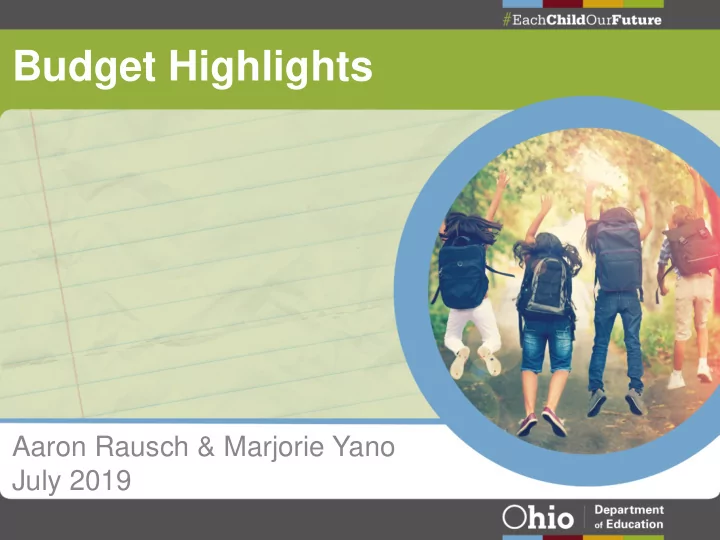

Budget Highlights Aaron Rausch & Marjorie Yano July 2019
Budget Highlights
Student Wellness and Success • $675 million in new funds for traditional districts, community schools, JVSDs and STEM schools over the biennium • Requires a plan to be developed and implemented with community partners
Student Wellness and Success Allowable Uses: • Mental health services • Services for homeless youth or child welfare involved youth • Community liaisons • Physical health care • Mentoring programs • Family engagement and support services • City Connects programming • Professional development on trauma-informed care or cultural competence • Before- and after-school programs
Student Wellness and Success Requires a plan to be developed with one or more of the following community partners: • A board of alcohol, drug and mental health services • An ESC • A county board of developmental disabilities • A community-based mental health treatment provider • A board of health of a city or general health district • A county department of job and family services • A nonprofit organization with experience serving children • A public hospital agency
Student Wellness and Success • $275 million in FY20 and $400 million in FY21 • Provided on a per-pupil basis, scaled based on federal census poverty data. • Every district will receive at least $25,000 in FY20 and $36,000 in FY21. • Paid directly to each district based on the number students educated (enrollment).
Student Wellness and Success • Distributed in two payments in October and February, through the foundation payment process. • Funds can be used for existing initiatives and activities in the context of the plan. • Districts must report how funds were spent following the end of each fiscal year (June 30).
Foundation Funding • School foundation funding is guaranteed/flat to FY19 levels for FY20 and FY21 • Student Success and Wellness dollars provided in addition to Foundation Funding.
Foundation Funding • Growing school districts will receive additional funding in FY20 and FY21 • Payment reports will be updated to reflect these changes and the Student Success and Wellness funds by October
Foundation Funding FY20 and FY21 Total Formula Funding Fixed to FY19 Levels
Foundation Funding Fixed to FY19 Levels Calculated based on current year data; Enrollment Growth Supplement and Student Wellness Dollars Added Calculated based on current year data
Academic Distress Commissions • Establishes a moratorium on any new ADCs for the 2019- 2020 school year • Current ADCs are unaffected and remain in place • New ADCs may be formed beginning in the 2020-2021 school year, if there is no additional legislative activity
Graduation Requirements Effective for the class of 2023 Optional for students in the classes of 2018, 2019, 2020, 2021 and 2022
Graduation Requirements To qualify for a high school diploma, students must continue to meet all curriculum requirements and: Attain a “competent” score on the 1. Algebra I and English language arts II end-of-course exam, or complete an alternative pathway to showing competency. 2. Attain at least two diploma seals, one of which must be a state- level seal, such as the existing biliteracy seal or the OhioMeansJobs-readiness seal.
Report Cards Modifies the grade scale used to determine letter grades assigned for the value-added progress dimension Letter Grade Score A 1 or greater B Less than 1 but greater than -1 C Less than or equal to -1 but greater than -2 D Less than or equal to -2 but greater than -3 F Less than or equal to -3
Industry-Recognized Credentials • $8 million each year for credential reimbursement. • Schools must notify students when their career-tech course can terminate in an industry recognized credential. • Requires schools to pay the cost of credential exam.
Industry-Recognized Credentials Provides $12.5 million each year to pay schools $1,250 for each student who earns a qualifying credential Incentivizes schools to establish qualifying credentialing programs, with $4.5 million in each fiscal year designated for this purpose
Educators Increases the statutory minimum salary for school districts and ESCs from $20,000 to $30,000 for teachers with a bachelor’s degree
Educators • College Credit Plus: The budget dedicates $3 million for high school teachers to take graduate-level coursework to qualify to teach college-level classes. • The budget provides $1.5 million to reimburse educators who pursue a credential in computer science.
Behavioral Prevention Initiatives An additional $2 million over the biennium will allow the Department to partner with Educational Service Centers to provide professional development to schools in support of this work.
Behavioral Prevention Initiatives • Requires schools to report the types of behavioral prevention services, programs and supports being used to promote healthy behavior and decision-making by students. • Continues the School Climate Grants at $2 million each fiscal year.
Options for Schools and Students Requires school districts and chartered nonpublic schools to accept one unit of computer coding instruction toward meeting a foreign language requirement for graduation.
Options for Schools and Students • Permits school districts and chartered nonpublic schools to allow students use two full seasons of show choir to fulfill high school P.E. requirements. • Modifies provisions originally included in H.B. 410 to specify that only a student’s non -medical excused absences and unexcused absences are considered in determining whether a student is excessively absent, triggering a required notice.
Transportation Expands the list of persons authorized to provide medical exams for bus drivers to include chiropractors and medical examiners.
Transportation Prohibits a school district from reducing transportation it has opted to provide for students after the school year starts
School Breakfast Requires higher- poverty public schools to offer breakfast to all students before or during the school day
Let’s Stay Connected Aaron.Rausch@education.ohio.gov Marjorie.Yano@education.ohio.gov 614-995-9936 614-995-9932
@OHEducation
Share your learning community with us! #MyOhioClassroom Celebrate educators! #OhioLovesTeachers
Recommend
More recommend